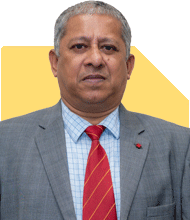I'm a young adult, and the cost of living is soaring. How can I manage my finances without sacrificing my lifestyle?
Milind Vadjikar |1153 Answers |Ask -Follow
Insurance, Stocks, MF, PF Expert - Answered on Apr 02, 2025
He has a mechanical engineering degree from Government Engineering College, Sambhajinagar, and an MBA in international business from the Symbiosis Institute of Business Management, Pune.
With over 16 years of experience in stock investments, and over six year experience in investment guidance and support, he believes that balanced asset allocation and goal-focused disciplined investing is the key to achieving investor goals.... more

With the cost of living rising sharply, many households are struggling to stay on top of their finances. What practical budgeting techniques can help people manage their expenses more effectively without drastically reducing their quality of life?
You can get many budgeting methods online however the key is the strict fiscal discipline, optimal asset allocation and frugal shopping.
Few measures to improve monthly budget:
1. Mind your credit card spends and ensure timely payment.
2. Avoid impulse purchases.
3. Limit discretionary spending.
4. Avoid FOMO shopping.
5. Prefer E-Com/Q-Com to get price benefits but only from reputed portals.
6. Keep 6-8 month worth regular expenses coverage corpus as emergency fund.
7. Be adequately insured for life as well as health.
Given below two budgeting methods:
1. 50/30/20 method
Traditionally in this method it advocates that 50% of your income should go towards essential needs, 30% for discretionary needs and balance 20% for investment, however I prefer to flip it in this way:
50% Investments
30%: Essential needs
20%: Discretionary needs
2. Pay yourself first budget
The pay yourself first budget is another simple budgeting method focusing basically on savings and debt repayment. With this method, you set aside a specific amount from each monthly income for savings and debt repayments, spending the rest as you feel appropriate.
Best wishes;
You may like to see similar questions and answers below
Moneywize |181 Answers |Ask -Follow
Financial Planner - Answered on Jan 15, 2024
Ramalingam Kalirajan |8192 Answers |Ask -Follow
Mutual Funds, Financial Planning Expert - Answered on Jul 06, 2024
Ramalingam Kalirajan |8192 Answers |Ask -Follow
Mutual Funds, Financial Planning Expert - Answered on Jul 15, 2024
Ramalingam Kalirajan |8192 Answers |Ask -Follow
Mutual Funds, Financial Planning Expert - Answered on Apr 02, 2025
Dr Nagarajan Jsk |314 Answers |Ask -Follow
NEET, Medical, Pharmacy Careers - Answered on Apr 06, 2025
Dr Nagarajan Jsk |314 Answers |Ask -Follow
NEET, Medical, Pharmacy Careers - Answered on Apr 06, 2025
Dr Nagarajan Jsk |314 Answers |Ask -Follow
NEET, Medical, Pharmacy Careers - Answered on Apr 06, 2025
Dr Nagarajan Jsk |314 Answers |Ask -Follow
NEET, Medical, Pharmacy Careers - Answered on Apr 06, 2025
Dr Nagarajan Jsk |314 Answers |Ask -Follow
NEET, Medical, Pharmacy Careers - Answered on Apr 06, 2025
Radheshyam Zanwar |1519 Answers |Ask -Follow
MHT-CET, IIT-JEE, NEET-UG Expert - Answered on Apr 06, 2025
Dr Nagarajan Jsk |314 Answers |Ask -Follow
NEET, Medical, Pharmacy Careers - Answered on Apr 06, 2025
Dr Nagarajan Jsk |314 Answers |Ask -Follow
NEET, Medical, Pharmacy Careers - Answered on Apr 06, 2025
Dr Dipankar Dutta |1093 Answers |Ask -Follow
Tech Careers and Skill Development Expert - Answered on Apr 05, 2025
Prof Suvasish Mukhopadhyay |552 Answers |Ask -Follow
Career Counsellor - Answered on Apr 05, 2025





















